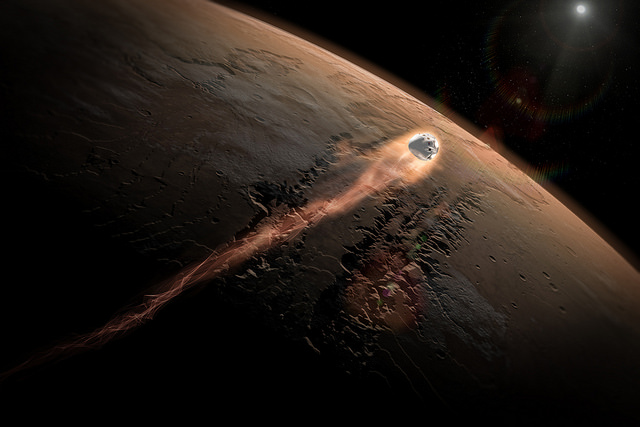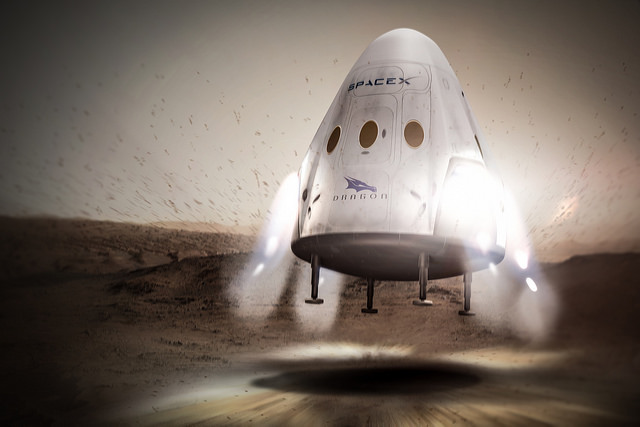Red Dragon | Photo: SpaceX, CC0 (Public Domain)
Most Definitely the Beagle

In December 2003, the Mars landing of the British spacecraft Beagle 2 did not go as planned. Instead of landing, unfolding its solar cells, and calling home, all the ESA heard back was silence. In early 2004 the craft was declared lost and assumed destroyed on impact, and it wasn’t until last year that it was found again by the camera of the Mars Reconnaissance Orbiter. The pictures were blurry, but it’s distinctive flower-petal shape seemed unmistakable: its solar panels had failed to fully deploy, and as a result it hadn’t been able to collect enough sunlight to function. Now a team of researchers has managed to sharpen up the blurry images, so that if you weren’t sure it was the Beagle 2 before, you should be now. The two researchers at the UCL Mullard Space Science Laboratory created a way of turning the usually 30cm-per-pixel images into 5cm-per-pixel images, by using images of the same locations from different points in the probe’s 300km-high orbit. With this technique, which they call Super Resolution Restoration, the details of the unlucky craft really come in to view. The new technique will help researchers to make the most of orbital cameras and give us the best images yet from high above Mars. Wired has more on the story.
The Necessaries of Life

Two parents in Alberta were convicted by a jury this week of “failing to provide the necessaries of life” regarding the death of their son Ezekiel in 2012. The 19-month-old died of bacterial meningitis after a two and a half week long illness the couple believed to be croup or the flu. According to the CBC, the couple “treated him for 2½ weeks with remedies that included hot peppers, garlic, onions and horseradish and a product from a naturopathic doctor aimed at boosting his immune system,” and only called for medical help when the child stopped breathing. It’s hard not to have sympathy for the parents, who in all honesty have probably suffered more from their child’s death than any sentence that could be handed down when that part of the trial takes place. But as the prosecutor said after the verdict was handed down, “what we hope that the public and the community takes away from this particular trial and the verdict in this trial is that all parents are held to a minimum standard of care that all children should expect at all times.” David Stephan, the father of the child, vented on Facebook after the verdict, writing that “the flood gates have now been opened and if we do not fall in line with parenting as seen fit by the government, we all stand in risk of criminal prosecution,” but it’s hard to see his point. If “parenting as seen fit by the government” includes “taking your sick child to the doctor instead of a snake-oil salesman ‘naturopath’,” then that’s a pretty damned low bar. The CBC has more on the story.
Red Dragon

No rundown of this week’s most interesting news would be complete without mention of SpaceX’s announcement that it plans to land an unmanned Dragon capsule on the surface of Mars “as early as 2018.” The news came in the form of a tweet from the official SpaceX twitter feed: “Planning to send Dragon to Mars as soon as 2018. Red Dragons will inform overall Mars architecture, details to come.” Elon Musk tweeted shortly afterward that of course he wouldn’t recommend sending humans to Mars in a Dragon capsule, since it “wouldn’t be fun for longer journeys” than just cislunar space, because the “internal volume [is] ~size of [an] SUV.” The key technology they’ll be testing by sending a Dragon capsule to Mars, in a mission deemed “Red Dragon,” is the propulsive landing technology. Because the Martian atmosphere is so thin, parachutes and ablatives are a whole lot less effective at slowing down things moving fast enough to get there. This puts an upper limit on the mass of things we can send there right now. NASA has been working on an inflatable, deployable “flying saucer”-shaped device to increase drag in the thin atmosphere (HIAD) and a less-successful (so far) parachute that’s deployable at supersonic speeds. But having rockets to slow you down and land with — something SpaceX is particularly good at — would go a long way toward making a manner Mars mission a real possibility. You can read a great, detailed piece on the topic over at the Verge for more.
In related news, SpaceX will launch again from Cape Canaveral May (NET) May 5, trying to stick the barge landing of the first stage for a second time. I’m always hopeful, but do bear in mind that this is still experimental, not routine.
ICYMI
This week, as usual, we got up to a lot here on the blog. Here’s a rundown in handy point form!
- On Monday I talked about how spraying for Gypsy Moths with inactive bacteria is actually a great way to do it
- On Tuesday I pointed out that there’s another outbreak of measles in the US
- On Wednesday I got a little pedantic about that “one minute of exercise” headline that was going around
- On Thursday I verbally shrugged about Mercury “going retrograde,” and
- On Friday, Lindsey used the words “teens” and “cosmetic labiplasty” and “trend” in uncomfortable conjunction
If you missed any of it, go check it out now!
Best of the Rest
And here it is, your weekly linkspam of interesting news:
- Cassini’s still revealing amazing things about Saturn’s moon Titan
- The James Webb Space Telescope’s beautiful golden mirror has been revealed
- The new CBS Star Trek tv show is going to be shot in Toronto
- Japan’s designing trains that are really hard to see (so as not to spoil the views of the countryside)
- NASA’s testing out a simulator for Boeing’s Starliner crewed transport controls
- Phil Plait heaved another exasperated sigh at things people will believe on the internet, and
- My favourite mad scientist Colin Furze got money from Ford to build a homebrew hoverbike (seriously!)
That’s all for today. I’ll leave you lovely people with this: a gif of Bill Nye the Science Guy (CEO of the Planetary Society) doing a merry jig.
Remember, I only get paid in my own (and your) enthusiasm, so please like This Week In Tomorrow on Facebook, follow me on Twitter @TWITomorrow, and tell your friends about the site!
If you like our posts and want to support our site, please share it with others, on Facebook, Twitter, Reddit — anywhere you think people might want to read what we’ve written. Thanks so much for reading, and have a great week.


